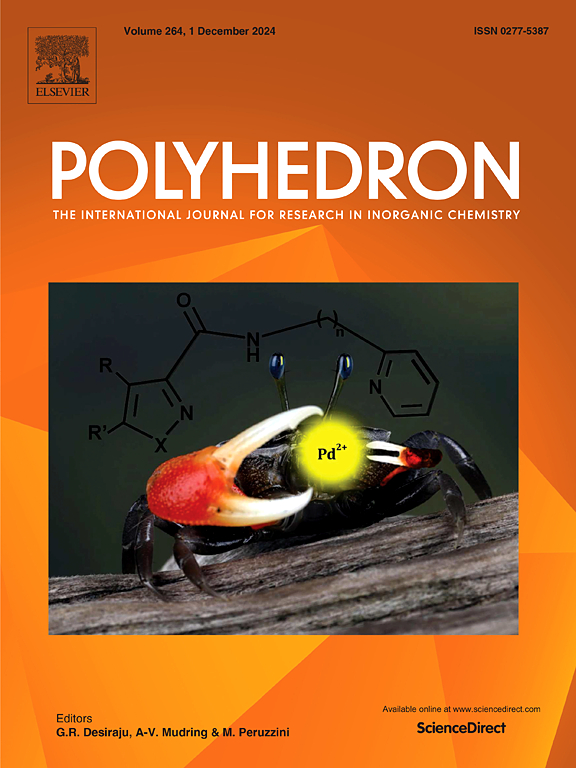吡啶基丙二酸二腙的双核铜(II)、镍(II)和镉(II)配合物的结构模式和细胞毒性活性
IF 2.4
3区 化学
Q2 CHEMISTRY, INORGANIC & NUCLEAR
引用次数: 0
摘要
通过直接合成法获得了 2-乙酰基吡啶与丙二酸二酰肼(H2L)的缩合衍生物[Cu2(L)(H2L)](ClO4)2-4H2O(Cu-1)的双核 Cu(II)配合物。重结晶后的单晶产品通过单晶 X 射线衍射分析、EPR、紫外/可见光和红外光谱进行了表征。在生成的二聚铜(II)配合物中,一个配体分子以二离子形式配位,而另一个配体分子则以中性形式配位。两个配体都通过一个 NNO 供体原子组采用双三叉配位模式。高氯酸盐离子和水分子位于外配位层,这与电导测量结果一致。铜(II)离子周围的配位几何为扭曲的八面体。使用 FIM(全相互作用图)方法和 Hirshfeld 表面分析法进行结构比较分析、通过分子间相互作用的二维指纹图谱进行比较结构分析,发现 Cu-1 与之前合成的 Ni(II) 复合物 [Ni2(HL)H2L](ClO4)3∙3DMSO (Ni-1) 和 [Ni2(H2L)2](ClO4)4∙4DMSO-EtOH (Ni-2) 以及 Cd(II) 复合物 [Cd2(H2O)2(H2L)2](ClO4)4-4H2O (Cd-1) 在结构上存在显著差异。最后,对这些双核复合物的细胞毒性活性进行了评估,并根据它们的半最大抑制浓度值进行了比较。本文章由计算机程序翻译,如有差异,请以英文原文为准。

Structural patterns and cytotoxic activity of dinuclear Cu(II), Ni(II) and Cd(II) complexes with pyridine-based malonic acid dihydrazone
A dinuclear Cu(II) complex, [Cu2(L)(H2L)](ClO4)2·4H2O (Cu-1), with a condensation derivative of 2-acetylpyridine and malonic acid dihydrazide (H2L), was obtained through a direct synthesis. After recrystallization, the single-crystalline product was characterized by single crystal X-ray diffraction analysis, EPR, UV/Vis and IR spectroscopy. In the resulting dimeric Cu(II) complex, one ligand molecule is coordinated in its dianionic form, while the other is coordinated in its neutral form. Both ligands adopt a bis-tridentate coordination mode through an NNO donor atom set. Perchlorate ions and water molecules are in the outer coordination sphere, consistent with the conductometric measurement. The coordination geometry around the Cu(II) ion is distorted octahedral. Comparative structural analysis using FIM (Full interaction map) methodology and Hirshfeld surface analysis, along with 2D fingerprint plots of intermolecular interactions revealed significant structural differences among Cu-1 and previously synthesized Ni(II) complexes [Ni2(HL)H2L](ClO4)3∙3DMSO (Ni-1) and [Ni2(H2L)2](ClO4)4∙4DMSO·EtOH (Ni-2), as well as Cd(II) complex [Cd2(H2O)2(H2L)2](ClO4)4·4H2O (Cd-1). Finally, the cytotoxic activities of these dinuclear complexes were evaluated with comparisons drawn based on their half-maximal inhibitory concentration values.
求助全文
通过发布文献求助,成功后即可免费获取论文全文。
去求助
来源期刊

Polyhedron
化学-晶体学
CiteScore
4.90
自引率
7.70%
发文量
515
审稿时长
2 months
期刊介绍:
Polyhedron publishes original, fundamental, experimental and theoretical work of the highest quality in all the major areas of inorganic chemistry. This includes synthetic chemistry, coordination chemistry, organometallic chemistry, bioinorganic chemistry, and solid-state and materials chemistry.
Papers should be significant pieces of work, and all new compounds must be appropriately characterized. The inclusion of single-crystal X-ray structural data is strongly encouraged, but papers reporting only the X-ray structure determination of a single compound will usually not be considered. Papers on solid-state or materials chemistry will be expected to have a significant molecular chemistry component (such as the synthesis and characterization of the molecular precursors and/or a systematic study of the use of different precursors or reaction conditions) or demonstrate a cutting-edge application (for example inorganic materials for energy applications). Papers dealing only with stability constants are not considered.
 求助内容:
求助内容: 应助结果提醒方式:
应助结果提醒方式:


